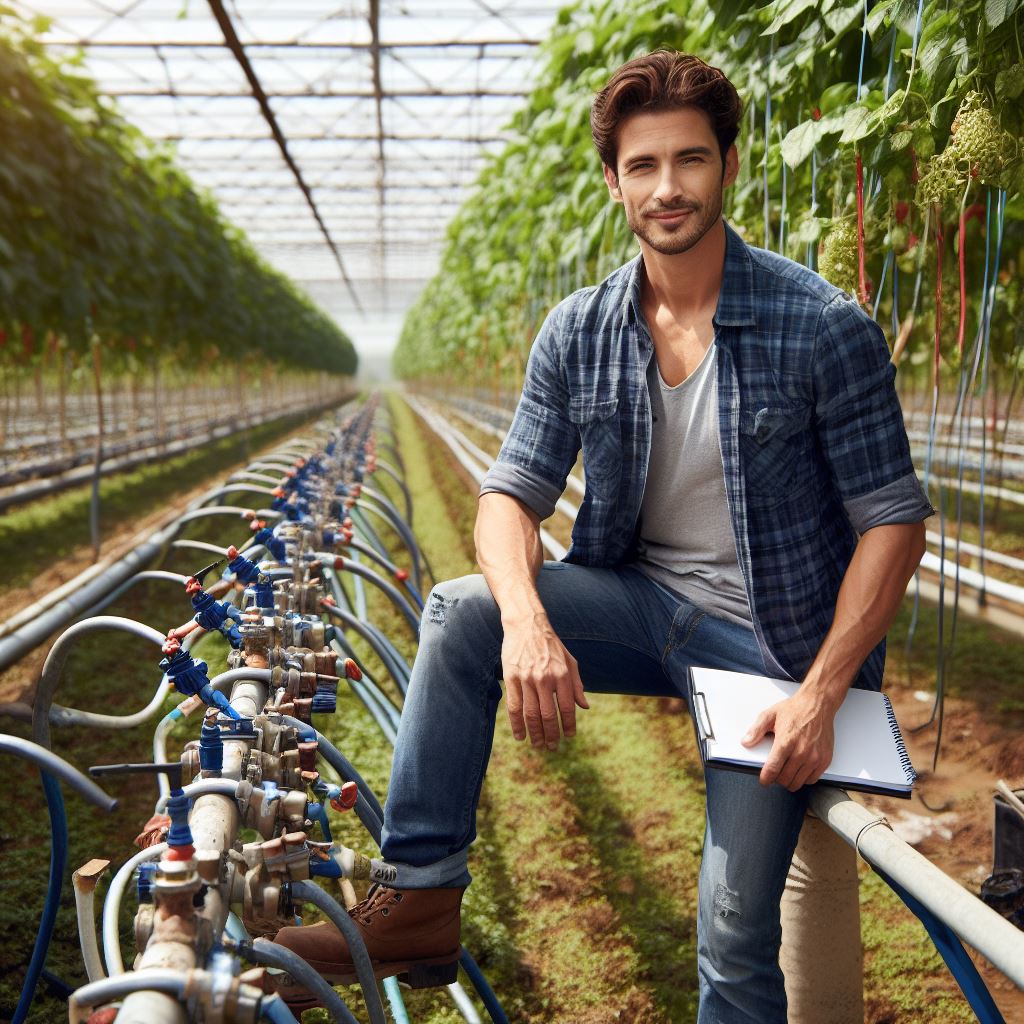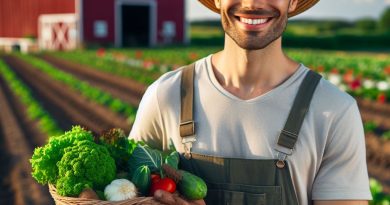Climate-Smart Agriculture: Adapting to Change
Last Updated on November 28, 2023
Introduction
Climate-smart agriculture is a concept that focuses on adapting to climate change in agriculture.
Adapting to climate change in agriculture is crucial for ensuring food security and sustainability.
Climate-smart agriculture is an approach that aims to address the challenges posed by climate change in agriculture.
It focuses on practices that not only mitigate greenhouse gas emissions but also enhance resilience and increase productivity.
Adapting to climate change in agriculture is essential due to the increasing frequency and intensity of extreme weather events.
These events, such as droughts, floods, and heatwaves, have severe impacts on crop yields, livestock production, and overall agricultural systems.
Moreover, climate change affects the availability and quality of water, soil fertility, and pest and disease dynamics.
Thus, adapting to these changes is crucial to ensure sustainable food production and livelihoods for farmers.
By implementing climate-smart practices, such as agroforestry, conservation agriculture, and improved water management, agriculture can become more resilient to climate change.
These practices help to conserve natural resources, improve soil health, and increase the adaptive capacity of farming systems.
In addition, climate-smart agriculture also contributes to mitigating climate change by reducing greenhouse gas emissions.
Sustainable land management practices, such as carbon sequestration in soils and agroforestry, can help to offset emissions from agriculture.
Overall, climate-smart agriculture is essential in adapting to climate change and ensuring food security.
It is crucial to invest in research, policy support, and capacity building to promote the adoption of climate-smart practices in agriculture.
By doing so, we can secure a sustainable and resilient future for agriculture and the planet.
Overview of Climate-Smart Agriculture
Climate-smart agriculture refers to a sustainable and resilient approach that aims to transform and reorient agricultural systems to effectively address the challenges posed by climate change.
This concept encompasses three key pillars: productivity, adaptation, and mitigation.
The Three Pillars of Climate-Smart Agriculture
- Productivity: One of the pillars of climate-smart agriculture is productivity. This involves continuously enhancing agricultural yields and improving resource-use efficiency. It focuses on implementing innovative farming techniques and technologies to increase crop yields and reduce waste, ensuring global food security.
- Adaptation: The second pillar, adaptation, entails adjusting agricultural practices to changing climate conditions. It emphasizes the development and implementation of strategies that enable farmers to cope with the impacts of climate change, such as drought, flooding, and extreme weather events. This is essential for maintaining livelihoods and food production in the face of uncertainty.
- Mitigation: Mitigation is the third pillar of climate-smart agriculture. It refers to practices that contribute to reducing greenhouse gas emissions from agricultural activities. This can include adopting sustainable land management practices, utilizing renewable energy sources, and minimizing the use of synthetic fertilizers and other inputs.
Benefits and Goals of Climate-Smart Agriculture
Climate-smart agriculture offers a multitude of benefits for both farmers and the environment.
First and foremost, it enhances the resilience of agricultural systems, making them more adaptable to climate change impacts.
By improving soil health and water management practices, it reduces vulnerability and promotes sustainable production.
Additionally, climate-smart agriculture helps mitigate climate change by reducing greenhouse gas emissions.
This is achieved through practices such as agroforestry, conservation agriculture, and integrated crop-livestock systems.
By sequestering carbon and using resources efficiently, it contributes to global efforts towards a low-carbon economy.
Furthermore, climate-smart agriculture contributes to rural development by fostering economic growth, improving food security, and reducing poverty.
It empowers smallholder farmers and promotes inclusive and sustainable agricultural value chains.
The Role of Farmers, Policymakers, and Researchers
Farmers play a crucial role in implementing climate-smart practices.
They are the primary stewards of the land and have firsthand experience in dealing with climate change impacts.
Through training and capacity building programs, farmers can adopt climate-smart practices and share their knowledge and experience with others in their communities.
Policymakers have the responsibility of creating an enabling environment for the widespread adoption of climate-smart agriculture.
This includes designing supportive policies, providing financial incentives, and promoting research and innovation.
Policymakers should also ensure that smallholder farmers have access to markets, information, and technology that support climate-smart agriculture.
Researchers aid in the development and dissemination of climate-smart technologies and practices.
They conduct scientific studies, field trials, and provide evidence-based recommendations for farmers and policymakers.
By collaborating with farmers and policymakers, researchers enable the co-creation of knowledge that facilitates the adoption and scaling up of climate-smart agriculture.
In short, climate-smart agriculture is a holistic approach that addresses productivity, adaptation, and mitigation.
Its implementation requires active engagement from farmers, policymakers, and researchers.
Read: Urban Farming: Growing Food in City Spaces
Impact of Climate Change on Agriculture
Climate Impact
- Unpredictable weather, including droughts and storms, reduces crop yields and livestock productivity.
- Pest and disease outbreaks increase due to climate-induced changes.
Challenges for Farmers
- Changing rainfall disrupts crop planning.
- Extreme events like floods and hurricanes cause economic losses.
- Rising temperatures stress livestock, affecting milk production and weight.
Adaptation Strategies
- Diversify crops and livestock for climate resilience.
- Implement innovative irrigation methods for water conservation.
- Adopt agroforestry to provide shade and reduce stress.
- Use improved genetics for climate-resilient crops and breeds.
- Practice sustainable soil management with conservation tillage and cover cropping.
Information and Support
- Invest in climate information and early warning systems.
- Develop policies and financial support to incentivize climate-smart practices.
- Enable farmers to anticipate weather risks and make informed decisions.
In general, agriculture faces significant challenges from climate change, necessitating farmers’ adaptation through the implementation of climate-smart practices.
This proactive approach not only ensures resilience in the agricultural sector but also promotes sustainable food production while upholding environmental responsibility.
By embracing innovative strategies and cultivating resilience, farmers play a crucial role in mitigating the impacts of climate change on agriculture and fostering a sustainable and environmentally conscious future.
Read: Permaculture Basics: Nature’s Way in Agriculture
Adaptation Strategies
1. Various Adaptation Strategies in Climate-Smart Agriculture
Climate-smart agriculture involves implementing various strategies to adapt to changing climate conditions.
These strategies aim to ensure agricultural productivity and sustainability.
2. The Importance of Developing Drought-Resistant Crops
With the increasing frequency and severity of droughts, developing drought-resistant crops becomes crucial.
These crops can withstand water scarcity and still maintain adequate yields.
3. Talk about the Value of Crop Diversification and Integrated Pest Management
Crop diversification plays a significant role in climate-smart agriculture.
By growing multiple crops, farmers can spread their risks and reduce vulnerability to climate-related disasters.
Integrated pest management techniques also help minimize crop loss due to pests and diseases.
4. The Use of Precision Agriculture Techniques to Optimize Resource Use
Precision agriculture, utilizing modern technology such as GPS and remote sensing, allows farmers to optimize inputs like water and fertilizers.
This precision ensures efficient resource use, reducing environmental impact and increasing crop productivity.
5. Mention the Significance of Improving Water Management Practices
Water is a vital resource for agriculture, and its management must be improved.
Implementing efficient irrigation systems, such as drip irrigation, and adopting water-saving practices can reduce water consumption and ensure its availability for future generations.
Farmers adapt for sustainable agriculture amid climate impacts.
Climate-smart agriculture deploys strategies, ensuring food security and reducing climate change impacts.
Developing drought-resistant crops is crucial; scientists and breeders employ selective breeding and genetic engineering.
Crop diversification spreads risks, providing a safety net against climate disasters.
Integrating pest management prevents crop destruction, reducing economic and environmental impact.
Precision agriculture, using GPS and remote sensing, maximizes resource efficiency, minimizing wastage for improved sustainability.
Improving water management copes with changing precipitation and water scarcity.
Efficient irrigation, like drip irrigation, conserves water, ensuring crops receive adequate supply and protects water quality.
Collaborative efforts of scientists, policymakers, and farmers are vital in building resilience.
Adoption of adaptation strategies is crucial for agricultural system resilience, navigating climate change challenges, ensuring productivity, and sustainability for future generations.

Mitigation Strategies
Reducing greenhouse gas emissions in agriculture is crucial for mitigating climate change. There are several strategies that can be implemented to achieve this goal.
1. Implementing precision agriculture techniques
Precision agriculture involves using technology and data to optimize resource use, such as water, fertilizers, and pesticides.
This helps reduce emissions and increases efficiency.
2. Adopting nutrient management practices
Proper management of nutrients, such as using organic fertilizers, can reduce greenhouse gas emissions from agriculture.
This includes avoiding excessive use of synthetic fertilizers, which can release nitrous oxide—a potent greenhouse gas.
3. Promoting sustainable land management practices
Sustainable land management practices, such as conservation tillage and cover cropping, can help sequester carbon in the soil.
These practices improve soil health, increase resilience to climate change, and reduce emissions.
4. Integrating livestock and crop production systems
Integrated farming systems, where livestock and crop production are combined, can reduce emissions.
For example, animal waste can be used as fertilizer, reducing the need for synthetic fertilizers.
5. Harnessing the potential of agroforestry
Agroforestry is a land use system that combines the cultivation of trees with crops or livestock.
Trees sequester carbon dioxide, provide shade, and regulate microclimates, making it a valuable strategy for climate change mitigation.
6. Encouraging afforestation and reforestation
Planting trees in areas where they were previously absent (afforestation) or replacing trees in deforested areas (reforestation) can help absorb carbon dioxide from the atmosphere and mitigate climate change.
7. Promoting renewable energy in agriculture
Switching to renewable energy sources, such as solar or wind power, for agricultural operations can reduce greenhouse gas emissions.
This includes using renewable energy for irrigation pumps, machinery, and processing facilities.
8. Enhancing water management practices
Efficient irrigation systems, such as drip irrigation, can reduce water use and the associated emissions.
Integrating water management into climate-smart agriculture is crucial for sustainability and emissions reduction.
9. Supporting research and innovation
Continued research and development of innovative technologies and practices are essential for effective greenhouse gas mitigation in agriculture.
This includes exploring new crop varieties, breeding techniques, and sustainable farming systems.
10. Strengthening policy frameworks
Governments should create policy frameworks that incentivize the adoption of climate-smart agriculture practices.
This can include financial incentives, subsidies, or tax breaks for farmers who implement emission reduction strategies.
In summary, implementing mitigation strategies in agriculture is vital for reducing greenhouse gas emissions and adapting to climate change.
By adopting sustainable land management practices, harnessing the potential of agroforestry, promoting renewable energy, and enhancing water management and nutrient practices, agriculture can become more climate-smart.
It is essential for governments, farmers, and stakeholders to collaborate and take collective action to mitigate the impacts of climate change on agriculture.
Read: Renewable Energy in Farms: Sun, Wind, Biomass
The Role of Technology in Climate-Smart Agriculture
When it comes to climate-smart agriculture, technological innovations play a crucial role in ensuring sustainable farming practices.
These advancements enable farmers to adapt to changing climatic conditions and improve their productivity while minimizing environmental impact.
Let’s discuss some key aspects of technology in climate-smart agriculture.
Precision Farming Technologies: Unlocking Potential
Precision farming technologies have revolutionized modern agriculture by providing farmers with tools to maximize efficiency and optimize resource allocation.
These technologies include GPS-guided machinery, drones, and sensor-based systems that monitor soil conditions, crop health, and water usage.
By collecting real-time data, farmers can make informed decisions to reduce inputs and improve yields.
Remote Sensing and Data Analytics: Informed Decision-making
The use of remote sensing and data analytics has been instrumental in climate-smart agriculture.
Satellite imagery and aerial photography help monitor crop growth, identify pest infestations, and detect water stress in large areas.
This information allows farmers to take timely action, reducing losses and improving overall farm management.
Importance of Digital Tools and Platforms
Incorporating digital tools and platforms in agriculture enhances efficiency and connectivity throughout the farming value chain.
Mobile applications, online marketplaces, and data-sharing platforms enable farmers to access information, connect with buyers and suppliers, and manage farm operations more effectively.
This digitization promotes knowledge exchange and empowers farmers with timely market insights.
Weather Forecasting and Predictive Analysis
Timely and accurate weather information is crucial for farmers to plan their activities and mitigate climate-related risks.
Weather forecasting tools, combined with historical and real-time data analysis, help predict climate patterns and extreme events.
This enables farmers to adjust their cultivation practices, protect crops from adverse conditions, and prevent crop losses.
Smart Irrigation Systems: Conserving Water Resources
Droughts and water scarcity are significant challenges in agriculture, necessitating the adoption of smart irrigation systems.
These systems use advanced sensors and automation to monitor soil moisture levels, optimize water usage, and reduce wastage.
By precisely delivering water to crops, farmers conserve water resources and ensure sustainable irrigation practices.
Vertical Farming and Controlled Environment Agriculture
Vertical farming and controlled environment agriculture offer innovative solutions to address climate change and food security concerns.
By growing crops in stacked layers using artificial lighting and controlled climate conditions, farmers can optimize land use, save water, and produce crops year-round.
These technologies reduce the reliance on traditional rain-fed agriculture and minimize weather-related risks.
The Role of Robotics and Artificial Intelligence
Robotics and artificial intelligence are transforming the agricultural landscape, enabling tasks such as planting, harvesting, and crop monitoring to be automated.
Robotic systems equipped with AI algorithms can precisely detect and remove weeds, apply targeted fertilizers, and perform labor-intensive activities.
This not only reduces labor costs but also enhances productivity while minimizing the environmental impact.
Challenges and Future Directions
While technological innovations hold immense potential for climate-smart agriculture, several challenges need to be addressed.
These include high initial costs, limited access to technology in certain regions, and the need for proper training and education.
Additionally, ensuring data security and privacy remains a crucial concern in the digital age.
In the future, further advancements in technology, coupled with supportive policies and investments, will be essential to fully leverage the potential of climate-smart agriculture.
Promoting research and development, facilitating technology transfer to small-scale farmers, and enabling an inclusive digital ecosystem will be crucial in fostering sustainable and resilient agriculture.
Therefore, technology has become an indispensable tool in climate-smart agriculture. Its role in providing precise information, optimizing resource management, and automating tasks is transforming farming practices.
By harnessing the power of technology, farmers can adapt to climate change, minimize environmental impact, and ensure food security for future generations.
Read: Polyculture Farming: Diverse Crops, Better Yield
Conclusion
In closing, climate-smart agriculture plays a crucial role in adapting to change.
By implementing sustainable practices and adopting resilient farming techniques, farmers can effectively mitigate the impacts of climate change on their crops and livelihoods.
It is important to emphasize the need for collaboration and knowledge sharing among various stakeholders.
Governments, researchers, and farmers must work together to develop and disseminate climate-smart technologies and best practices.
This collaboration will ensure that farmers have access to the latest information and tools needed to adapt to changing climate conditions.
Furthermore, it is vital to encourage farmers to embrace climate-smart practices.
By implementing techniques such as conservation agriculture, agroforestry, and precision farming, farmers can increase their productivity while reducing the negative environmental impacts of agriculture.
These practices not only contribute to sustainable and resilient agriculture but also support the preservation of natural resources for future generations.
In a nutshell, climate-smart agriculture offers a viable solution to the challenges posed by climate change.
It provides a pathway towards sustainable and resilient farming systems, ensuring food security and livelihoods for farmers.
By adopting climate-smart practices and promoting collaboration, we can build a future where agriculture thrives despite the uncertainties of a changing climate.
It is time to prioritize climate-smart agriculture for the benefit of both present and future generations.
To achieve this, stakeholders must come together, share knowledge, and proactively implement climate-smart practices.


